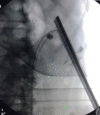Supine percutaneous nephrolithotomy: tips and tricks
- PMID: 31656744
- PMCID: PMC6790418
- DOI: 10.21037/tau.2019.07.09
Supine percutaneous nephrolithotomy: tips and tricks
Abstract
This paper aims to give an exhaustive overview of supine percutaneous nephrolithotomy (PCNL) illustrating some tips and tricks in order to optimize its execution in full safety. Critical review of Pros and cons of supine PCNL is accomplished to allow the urologist to experience the beauty of this position while being ready to overcome its minimal shortcomings.
Keywords: Percutaneous nephrolithotomy (PCNL); endourology; stone; supine.
2019 Translational Andrology and Urology. All rights reserved.
Conflict of interest statement
Conflicts of Interest: G Giusti: consultant for Coloplast, Rocamed, Olympus, Lumenis, Boston Scientific, BD-Bard, Cook Medical, Quanta System; S Proietti: consultant for Quanta System; B Eisner: consultant for Boston Scientific, Olympus, Kalera Medical, Sonomotion. The other authors have no conflicts of interest to declare.
Figures






References
-
- Valdivia Uría JG, Lachares Santamaría E, Villarroya Rodríguez S, et al. Percutaneous nephrolithectomy: simplified technic (preliminary report). Arch Esp Urol 1987;40:177-80. - PubMed
-
- Valdivia JG, Valer J, Villarroya S. Why is Percutaneous Nephroscopy Still Performed with the Patient Prone?* J Endourol 1990;4:269-77. 10.1089/end.1990.4.269 - DOI
Publication types
LinkOut - more resources
Full Text Sources
Miscellaneous
